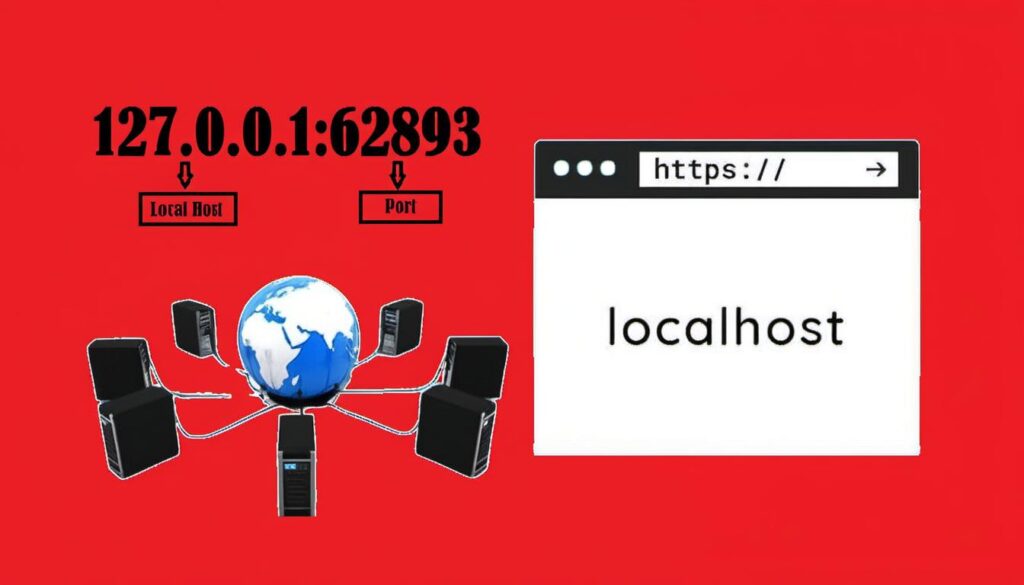In the world of networking and web development, the concepts of “localhost” and port numbers are foundational. These components are essential for IT professionals, including server administrators, web developers, and cybersecurity specialists. This overview provides insights into the role of 127.0.0.1:62893, explaining the significance of localhost and port numbers.
What is Localhost?
“Localhost” refers to the default hostname assigned to the local machine, translating to the loopback IP address. In IPv4, this address is typically 127.0.0.1, while in IPv6, it is represented as ::1. When you ping localhost or 127.0.0.1, you’re effectively sending a signal back to your own machine, making it a useful tool for testing network functionalities without the need for external communication.
Key Functions of Localhost:
- Testing and Development: Localhost enables developers to test web functionalities locally, without exposing them to the broader internet.
- Configuration and Troubleshooting: Network administrators often use localhost for troubleshooting network issues and configuring local interfaces. It creates a self-contained environment, speeding up processes and reducing risk.
The Loopback IP Address – 127.0.0.1
The 127.0.0.1 address, a part of the reserved 127.0.0.0/8 block, is specifically reserved for routing data back to the originating machine. Any data packet sent to an address within this block is looped back to the source, meaning it doesn’t interact with the physical network.
Importance of 127.0.0.1:
- Testing Network Applications: Developers can use this address to test software and services without external network interference.
- Network Troubleshooting: It’s helpful in diagnosing issues at the software level, remaining isolated from the physical network.
Understanding Ports
Ports are logical endpoints that allow multiple services to share a single network connection. They are identified by numbers, and there are 65,535 available ports for each IP address. For example, 127.0.0.1:62893 specifies an IP address (127.0.0.1) and a port (62893) used by a local service.
Types of Ports:
- Well-Known Ports (0-1023): These are reserved for common services like HTTP (port 80) and HTTPS (port 443).
- Registered Ports (1024-49151): These ports are assigned to specific services by the Internet Assigned Numbers Authority (IANA).
- Dynamic or Private Ports (49152-65535): These are used by applications for temporary communication and are not registered with IANA.
The Role of Port 62893
Port 62893 falls within the dynamic or private port range. While it is not assigned to a common service by IANA, it can be used by any application needing a unique communication endpoint. Developers prefer high-numbered ports like 62893 to avoid conflicts with well-known services, and to improve security by obscurity.
How Localhost and Port 62893 Work Together
When combined, 127.0.0.1 (localhost) and a specific port like 62893 designate a unique endpoint for communication on the local machine. For instance, running a web server on localhost:62893 means the server is hosted on the local machine’s IP (127.0.0.1) and listens on port 62893. This combination offers various benefits:
- Web Development Testing: Developers can run multiple services locally using different ports, testing features without external exposure.
- API Development: APIs can be hosted locally on various ports, streamlining microservices development.
- Security: Running services on localhost minimizes the risk of attacks since the server isn’t externally accessible.
Practical Example: Using 127.0.0.1:62893
Here’s an example of how to set up a simple HTTP server using Python:
This script runs an HTTP server on http://127.0.0.1:62893, which is useful for testing before deployment.
Benefits of Using High-Numbered Ports
Using higher-numbered ports like 62893 for local development offers several advantages:
- Reduced Conflicts: By avoiding ports used by common services, you reduce the chance of conflicts.
- Improved Security: High-numbered ports are less likely to be targeted by attackers because they are not associated with standard services.
- Flexibility: Developers can run multiple instances of services on different ports simultaneously, simplifying testing and development workflows.
Configuring Localhost and Port Numbers for Various Applications
Understanding how to configure localhost with specific port numbers is crucial for various environments and services.
Example: Node.js Server
This Node.js snippet demonstrates setting up a basic HTTP server on 127.0.0.1:62893.
Example: PHP Server
You can run a simple PHP development server using the following command:
This command launches a PHP server on http://127.0.0.1:62893.
Networking Tools for Localhost Testing
Several tools can help you troubleshoot and test connectivity on localhost:
- Telnet: Tests connectivity to specific ports.
- Netstat: Displays active connections and listening ports.
- Netcat (NC): Reads from and writes to network connections.
These tools are vital for verifying service availability and diagnosing network issues on localhost.
Security Considerations with Localhost and Ports
Although localhost inherently reduces certain risks, security should remain a top priority:
- Access Control: Ensure sensitive services are secured, restricting access to localhost only.
- Firewalls: Configure local firewalls to control inbound and outbound traffic on specific ports.
- Patch Management: Regularly update software to mitigate vulnerabilities that could be exploited through open ports.
Troubleshooting Common Issues
- Port Conflicts: If a port is already in use, you’ll encounter a binding error. To resolve this, terminate the process using the port or select a different one.
- Firewall Restrictions: Ensure local firewall settings allow traffic on the required ports.
- Network Configuration Errors: Verify that the loopback interface is properly configured.
Conclusion
The combination of localhost (127.0.0.1) and specific port numbers, such as 62893, forms the basis for efficient local development, testing, and troubleshooting. Understanding how these components work together enhances productivity, security, and operational efficiency, whether you’re developing web applications, setting up local servers, or performing network diagnostics.






